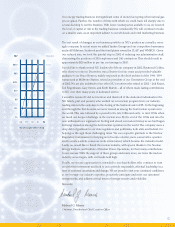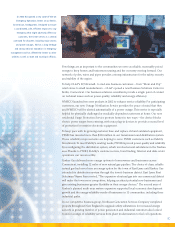Eversource 2002 Annual Report Download - page 19
Download and view the complete annual report
Please find page 19 of the 2002 Eversource annual report below. You can navigate through the pages in the report by either clicking on the pages listed below, or by using the keyword search tool below to find specific information within the annual report.
17
NU’s net cash flows provided by operating activities increased to $612.6
million in 2002, compared with $328.6 million in 2001 and $599.8 million
in 2000. Cash flows provided by operating activities increased primarily
due to increases in working capital items, primarily accrued taxes, offset
by a reduction in net income, primarily due to the gain associated with
the sale of Millstone in 2001. Accrued taxes increased because the taxes
related to the sale of Seabrook will not be paid until March of 2003. The
decrease in cash flows provided by operating activities in 2001 related
primarily to increases in receivables and unbilled revenues associated
with the sales growth of NU’s competitive energy subsidiaries.
There was a lower level of investing and financing activities in 2002
as compared to 2001, primarily due to the issuance of long-term debt,
issuance of rate reduction bonds and certificates and the buyout and
buydown of independent power producer contracts in 2001. The level
of common dividends totaled $67.8 million in 2002, compared with
$60.9 million in 2001 and $57.4 million in 2000. The increase resulted
from NU paying a $0.125 per share quarterly common dividend in the
first two quarters of 2002 and a $0.1375 per share quarterly dividend in
the last two quarters of 2002. The level of quarterly common dividend
payments during 2001 was $0.10 per share during the first two quarters
of 2001 and $0.125 during the last two quarters of 2001. The increase in the
common dividend was partially offset by a decrease in outstanding shares.
Management expects to continue to increase the dividend level, subject
to NU’s ability to meet earnings targets and the judgment of its Board
of Trustees at the time the dividends are declared. On January 13, 2003,
the NU Board of Trustees approved the payment of a $0.1375 per share
dividend payable on March 31, 2003, to shareholders of record at
March 1, 2003.
Despite the increase in the common dividend, NU parent ended the
year with a high level of liquidity, all of which was loaned to subsidiaries
through the NU Money Pool or through direct loans.The parent company’s
cash levels increased as a result of continued return of equity capital
from its regulated subsidiaries, as well as their payment of common
dividends to the parent. In 2002, CL&P paid $60.1 million of dividends
to NU parent and returned another $100 million of equity capital through
share repurchases. PSNH paid $45 million of dividends in 2002, in
addition to the return of another $37 million of equity capital. As a result
of the Seabrook sale, NAEC paid $5 million of dividends and returned
another $35 million of equity capital to NU. WMECO paid $16 million
of dividends and returned $14 million of equity capital to NU.The parent
company also received another $10 million in dividends from NGC through
its parent company, NUEI along with $3 million directly from NUEI.
The parent company’s liquidity is reinforced by no debt maturities, a
modest common dividend, and minimal sinking fund payments of $23
million in 2003 and $24 million in 2004. Equity capital transactions
between NU parent and its subsidiaries are eliminated in consolidation.
Regulated Utilities: NU’s regulated utilities had a modest level of financings
in 2002. In January 2002, PSNH issued an additional $50 million in rate
reduction bonds and used the proceeds to repay short-term debt that
was incurred to buyout a purchased-power contract in December 2001.
In April 2002, NU issued $263 million of 7.25 percent senior unsecured
notes due on April 1, 2012. Proceeds from the refinancing were used to
redeem a similar amount of variable rate notes that were issued on
February 28, 2001 related to the Yankee merger.
In November 2002, the regulated utilities renewed their $300 million
credit line, under terms similar to the arrangement that expired in
November 2002. A previous credit line had provided up to $350 million
for the regulated companies. There were $7 million in borrowings on
this credit line at December 31, 2002.
In addition to its revolving credit arrangement, CL&P can access up to
$100 million by selling certain of its accounts receivable. At December 31,
2002, CL&P had $40 million outstanding under this arrangement. The
current accounts receivable arrangement is expected to be renewed in
July 2003.
Rate reduction bonds are included on the consolidated balance sheets
of NU, CL&P, PSNH and WMECO, even though the debt is nonrecourse
to these companies. At December 31, 2002, these companies had a total
of $1.9 billion in rate reduction bonds outstanding, compared with $2
billion outstanding at December 31, 2001. All outstanding rate reduction
bonds of CL&P are scheduled to amortize by December 30, 2010, with
those of PSNH scheduled to fully amortize by May 1, 2013, and those
of WMECO scheduled to fully amortize by June 1, 2013. Interest on the
rate reduction bonds totaled $115.8 million in 2002, compared with
$87.6 million in 2001. Amortization of the rate reduction bonds totaled
$169 million in 2002, compared with $100 million in 2001. CL&P,
PSNH and WMECO fully recovered the amortization and interest
payments from customers in 2002 and the bonds had no impact on net
income. Moreover, because the debt is nonrecourse to these companies,
the three rating agencies that rate their debt and preferred stock securities
do not include the revenues, expenses, or outstanding securities related
to the rate reduction bonds in establishing the credit ratings of NU or
its subsidiaries.
CL&P and Yankee Gas have embarked upon significant upgrade programs
within their service territories. Over the past five years, CL&P has
increased its annual level of investment in electric utility plant by
approximately 50 percent. Much of the additional investment has been
devoted to improving the reliability of CL&P’s electric distribution system.
Over the next several years, CL&P has proposed a significant expansion
of its 345,000 volt electric transmission system into southwestern
Connecticut at a cost that is likely to exceed $500 million. If
Connecticut regulators approve the expansion, CL&P’s construction
expenditures are projected to exceed $350 million annually from 2004
through 2007. Such a program would exceed CL&P’s projections for
internally generated operating cash flows, and therefore, CL&P expects
to access the capital markets for financing during this period. In 2003,
CL&P is expected to generate enough cash internally to fund most,
if not all, of its capital needs.
Yankee Gas, pursuant to the recommendations of the Connecticut
Department of Public Utility Control (DPUC) when it approved NU’s
acquisition of Yankee, has embarked upon a significant expansion with-
in its service territory.Yankee has not paid a common dividend since it
merged with NU in 2000, using its internally generated cash to fund its
expansion program. This expansion will likely require Yankee Gas to
issue new debt. Although Yankee Gas’ debt is not currently rated,
management believes Yankee Gas would be able to attract capital at
a reasonable cost due to its regulated activities and strong balance
sheet. At December 31, 2002,Yankee Gas had $215.4 million of common
equity, excluding common equity related to goodwill, and $151.4 million
of long-term debt.
























